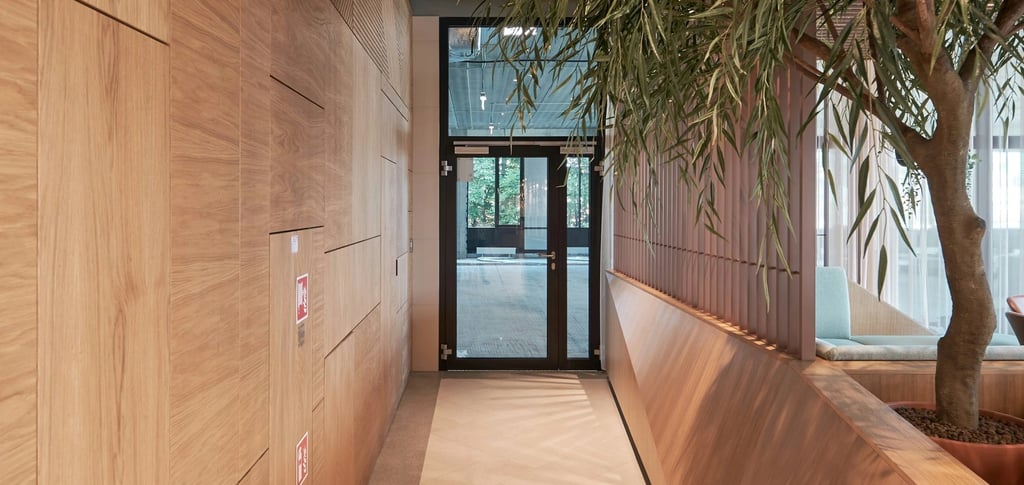The WELL Building Standard: A People-Centered Revolution in Design
This article explores how the WELL Building Standard has evolved from a niche idea into a global benchmark for health-first design. With over 5 billion square feet now certified worldwide, we look at the market impact, financial returns, and growing relevance in both commercial and residential development. It’s a reflection on what we’re learning, what’s still challenging, and how we can build better for people — together.
6/18/20255 min read


We’re in the middle of a health-first building revolution, and WELL is leading the charge. By focusing on occupant health and well-being, WELL has sparked explosive growth: as of early 2024 the standard was being applied across more than 5 billion square feet in 130 countries (and today it’s approaching 6 billion sq ft in 137 nations). This momentum shows that a growing community of developers, architects, and owners believe buildings should nurture human health, not just energy efficiency.
A WELL-inspired workspace often features abundant daylight, natural materials, and plants. WELL v2 now organizes building strategies into 10 concept categories, including Air, Water, Nourishment, Light, Movement (Fitness), Thermal Comfort, Sound, Materials, Mind, and Community. This holistic framework aims to support people’s health at every turn.
From V1 to V2: Ten Concepts of WELL
WELL v1 focused on things like Fitness and Comfort, but WELL v2 introduces a tighter, 10-category approach. These categories are:
Air – clean, filtered ventilation
Water – safe, taste-worthy hydration
Nourishment – access to healthy foods
Light – daylighting and circadian lighting design
Movement (Fitness) – spaces that encourage activity
Mind – strategies to support mental health and stress reduction
Thermal Comfort – ideal temperature and humidity for occupants
Sound – acoustics that reduce noise stress
Materials – low-toxicity construction and finishes
Community – fostering social equity and connectedness
Each concept is backed by evidence-based design and policies. (For example, WELL research shows that improving indoor air quality alone can boost cognitive scores by 61–101%.) Taken together, these categories create offices, homes, and other spaces that actively help people thrive.
Counting the Benefits: WELL’s Amazing ROI
It may seem surprising that focusing on human health can also be a smart investment. In fact, financial analyses find astronomical returns from WELL strategies. Muldavin Corp’s hypothetical model of a 200,000 ft² corporate headquarters shows that even a modest 0.5% gain in employee productivity yields an internal rate of return (IRR) near 300% and a net present value (NPV) of $5.6 million on a $427k WELL investment. If productivity rises 1.5%, IRR jumps to 527% (NPV ~$9.7M), and at 2.5% it reaches 758% (NPV ~$13.8M). These gains come through faster work (productivity), higher staff retention, and reduced absenteeism and healthcare costs. In short, healthier buildings pay off – stakeholders see returns measured in millions, driven by happier, healthier occupants.
Scenario 1: 0.5% productivity boost ⇒ IRR ≈ 298%, NPV ≈ $5.6M.
Scenario 2: 1.5% productivity boost ⇒ IRR ≈ 527%, NPV ≈ $9.7M.
Scenario 3: 2.5% productivity boost ⇒ IRR ≈ 758%, NPV ≈ $13.8M.
These numbers – IRRs from 298% to 758% – dwarf most traditional real estate returns, making WELL certification a powerful value proposition for investors and tenants alike.
Down Under: Australia Leads the Charge
Australia is a standout market for WELL. A 2020 industry note boasted that “more than 10% of all office space” in Australia is now registered or certified under WELL – a market penetration that puts it at the forefront globally. Major Australian firms are walking the talk: for example, Macquarie Group’s new HQ at 50 Martin Place became the first building in Australia to earn WELL certification. Property giants like Lendlease, Dexus, and others are also embracing WELL in their office portfolios. (Lendlease’s Barangaroo towers and Macquarie’s heritage HQ both pursued WELL Platinum, while Dexus has rolled out WELL Health-Safety Ratings across its assets.) This corporate demand is echoed by policy and advocacy: the Green Building Council of Australia works with IWBI on education and crosswalks, helping architects and builders add WELL to familiar Green Star projects.
Bridging WELL and LEED: Double Duty for Buildings
Rather than competing, WELL and LEED often go hand-in-hand. In 2023 IWBI announced a partnership with the USGBC to streamline dual certification. This means a project can pursue WELL and LEED in parallel, using a single review process. Within months, close to 350 projects (80 million sq ft across 38 countries) opted into this dual LEED+WELL pathway. The benefit is synergy: LEED covers energy, water, materials, while WELL adds the people-centric layer. By integrating WELL from the design phase, teams can claim credits or features in both systems (Green Star/WELL crosswalks do similar work in Australia). Dual-certified projects signal to tenants and investors that both planet and people are cared for, often commanding higher rents and valuations.
Healthy Homes, Healthy Premiums
WELL isn’t just for offices – it’s reshaping residential design too. Buyers are increasingly valuing health-positive home features. For example, Domain research found that energy-efficient (i.e. “green and healthy”) houses in Melbourne sold for 23.8% higher than ordinary homes – roughly a $197,000 premium on average. Solar panels, superior insulation, clean-air filters and natural-light orientation may not carry a WELL label in Australia yet, but they embody the same ethos. The data suggests that homes with better air quality, daylighting, and wellness amenities can command sizable market premiums. Developers and architects who bake wellness into housing – from smart ventilation to biophilic design – can tap into this growing demand.
Green, healthy homes are in demand. In Melbourne a report found energy-efficient homes sold for an average $197K more than standard homes, illustrating how health-focused features translate to real dollar value in the housing market.
Challenges and Learning Curves
Of course, moving from theory to practice isn’t always easy. Many Australian builders and architects are still learning what WELL certification entails. It’s one thing to chase green rating credits, another to implement 24/7 air quality monitoring or staff wellness policies. Some common hurdles include:
Awareness: Designers may not yet know WELL’s 100+ features or how to integrate them.
Expertise: Teams often need a WELL AP specialist to guide documentation and testing.
Cost & Schedule: Demonstrating thermal comfort or acoustics can require extra surveying or materials.
Culture Shift: Companies need to treat occupant health as a strategic priority.
These challenges aren’t insurmountable. The WELL community (especially WELL Accredited Professionals and consultants) is growing fast in Australia. Groups like IWBI and GBCA offer training (WELL AP courses, seminars, webinars) to bring architects, engineers, and even HR and facilities into the loop. Early adopters find that familiarity breeds efficiency: the first WELL project on your team is the hardest, but the next goes much smoother. We encourage firms to experiment – retrofit a WELL feature in one office, or pursue WELL Core & Shell on a redevelopment – and learn by doing.
Join the Conversation: Share Your WELL Experiences
The WELL movement thrives on knowledge-sharing. If you’re an architect, builder, or developer who’s dabbling in WELL for the first time, you’re not alone. Community forums, LinkedIn groups, and industry events are full of peers happy to discuss what worked (and what didn’t). Perhaps you’re curious about the documentation process, or how to pitch WELL’s benefits to a skeptical client – ask away! And for veteran WELL practitioners: your case studies can light the way for others.
We invite our design and construction community to share questions, successes or concerns about WELL. Whether it’s a quick tip on better ventilation or a graph of post-occupancy health improvements, your insight is valuable. Let’s keep this conversation open: by working together, we can help more people understand that building for wellness is both the right thing to do and a smart business move.
Have you worked on a WELL project, or thought about bringing wellness into your next design? Leave a comment below with your experiences or questions – we’d love to hear from you!
References: International WELL Building Institute (IWBI) reports and publications; GRESB insights; Green Building Council of Australia (GBCA) guidelines; McKinsey & Company research on quality of life and built environment.
© Wigwam Architects
Wigwam Architects Pty Ltd ATF Wigwam Trust ABN 77 283 233 729
Wigwam Architects respectfully acknowledges the Quandamooka people as the Traditional Custodians of the land on which we live and work. We honor their enduring connection to Country, community, and culture and recognize their deep knowledge and care for this land and its waterways. We pay our respects to Elders past, present, and emerging and extend that respect to all Aboriginal and Torres Strait Islander peoples today.


